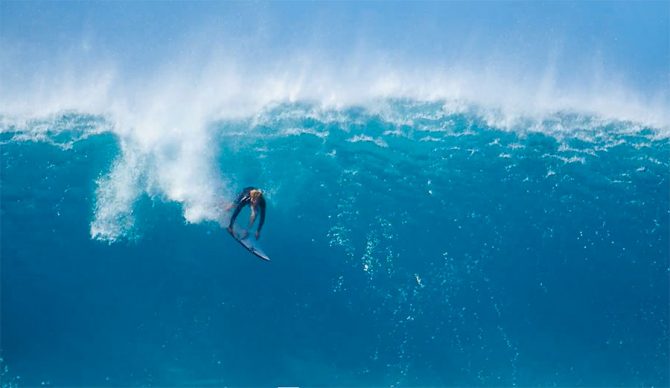
The pop up is one of the most important parts of surfing. If you don’t have it mastered, the rest will be that much harder. Photo: Shutterstock
Angling your take off allows you to drop in on waves that are steep and get racing down the line. Popping up with a slight angle will help you get to your feet with the momentum you need on a fast wave face, beating a fast first section and not finding yourself bogged down behind the peak. In many instances, not angling your take off can end your ride before it even gets started.
With that said, here is a step-by-step explanation of how beginning surfers can start to angle their takeoffs:
Step 1: Choose which way you are going to go: left or right.
Step 2: When you see the wave approaching, paddle into the best position for your take off.
Step 3: Get your board speed up by paddling perpendicular to the beach.
Step 4: Simultaneously to your final three or so strokes, start to angle your board in the direction you’ll want to go.
Step 5: Using the nose of the board as your guide, begin to mentally draw your line down the wave face ahead of you.
Step 6: As you prepare to pop up look in the direction of where you want to go, not focusing so much on where you actually are.
Step 7: Place both hands on the deck and open both your shoulders toward the angle you’ve chosen.
**Pro tip: Sometimes this means your outside hand is a little further up the board then your inside hand.
Step 8: Apply more pressure to your inside rail, as that will help angle your board.
Step 9: As you lift your chest up, bring your legs through. Place your back leg first on the tail pad and follow through with your front foot.
Step 10: Your back foot should be at a 90-degree angle and your front foot should be at a 45-degree angle on the deck of your board.
Step 11: Keep your knees slightly bent and arms close to your body.
Step 12: Surf in the middle of the wave face. Draw an imaginary line that goes down the middle of the wave face.
**Pro tip: If you feel like the wave is getting away from you, as in, it’s moving too fast, move your chin toward the board. This will give you extra paddle power by applying more pressure down and creating more planing surface.

John John, a master of the late take off.
Common Mistakes to avoid include:
X – If you paddle at too much of an angle or angle too early, you are going to come off the shoulder rather than into the wave.
X – If your angle is too slight, you’ll drop straight down the wave and end up back in the white water.
X – Don’t paddle into the wave and then begin to angle your board. The board won’t start turning until you start moving.
X – Just leaning on the rails as you drop down the face won’t be enough to angle your board. Those last three paddles really help to encourage your board and body on the angle you wish to take on the shoulder. They create the momentum you need.
X – In reality, you will want to draw your line a bit higher than the middle of the wave’s shoulder is breaking fast and a bit lower when it’s breaking slowly.
X – You might be surfing lower on the face than you think you are. Take note that most beginners think they are riding a higher line on the wave than they actually are. See yourself surfing through pictures and video as often as possible to verify where you draw your lines.
X – If your feet aren’t in the correct position your board will go in a different way to where your body is pointing.
X – Don’t look down at your feet as you pop up. As the saying goes, “If you look down, you go down.” So look to where you want to be on the wave and where you want your board to take you.
X – Don’t arch your back too much. Your momentum needs to be moving forward. If you arch your back too much, you are going to disrupt your forward motion.
You can find more how to surf tutorials here

